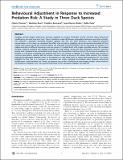Files in this item
Behavioural adjustment in response to increased predation risk : a study in three duck species
Item metadata
| dc.contributor.author | Zimmer, Cedric | |
| dc.contributor.author | Boos, Mathieu | |
| dc.contributor.author | Bertrand, Frederic | |
| dc.contributor.author | Robin, Jean-Patrice | |
| dc.contributor.author | Petit, Odile | |
| dc.date.accessioned | 2013-11-05T12:01:05Z | |
| dc.date.available | 2013-11-05T12:01:05Z | |
| dc.date.issued | 2011-04-20 | |
| dc.identifier | 43102303 | |
| dc.identifier | 43d988da-38c6-4f8a-8876-f76901c5ce07 | |
| dc.identifier | 000289719400043 | |
| dc.identifier | 79955394568 | |
| dc.identifier.citation | Zimmer , C , Boos , M , Bertrand , F , Robin , J-P & Petit , O 2011 , ' Behavioural adjustment in response to increased predation risk : a study in three duck species ' , PLoS One , vol. 6 , no. 4 , e18977 . https://doi.org/10.1371/journal.pone.0018977 | en |
| dc.identifier.issn | 1932-6203 | |
| dc.identifier.uri | https://hdl.handle.net/10023/4162 | |
| dc.description.abstract | Predation directly triggers behavioural decisions designed to increase immediate survival. However, these behavioural modifications can have long term costs. There is therefore a trade-off between antipredator behaviours and other activities. This trade-off is generally considered between vigilance and only one other behaviour, thus neglecting potential compensations. In this study, we considered the effect of an increase in predation risk on the diurnal time-budget of three captive duck species during the wintering period. We artificially increased predation risk by disturbing two groups of 14 mallard and teals at different frequencies, and one group of 14 tufted ducks with a radio-controlled stressor. We recorded foraging, vigilance, preening and sleeping durations the week before, during and after disturbance sessions. Disturbed groups were compared to an undisturbed control group. We showed that in all three species, the increase in predation risk resulted in a decrease in foraging and preening and led to an increase in sleeping. It is worth noting that contrary to common observations, vigilance did not increase. However, ducks are known to be vigilant while sleeping. This complex behavioural adjustment therefore seems to be optimal as it may allow ducks to reduce their predation risk. Our results highlight the fact that it is necessary to encompass the whole individual time-budget when studying behavioural modifications under predation risk. Finally, we propose that studies of behavioural time-budget changes under predation risk should be included in the more general framework of the starvation-predation risk trade-off. | |
| dc.format.extent | 9 | |
| dc.format.extent | 430368 | |
| dc.language.iso | eng | |
| dc.relation.ispartof | PLoS One | en |
| dc.subject | Predation risk | en |
| dc.subject | Trade-off | en |
| dc.subject | Behavioural modification | en |
| dc.subject | Diurnal time-budget | en |
| dc.subject | Mallard duck | en |
| dc.subject | Teal duck | en |
| dc.subject | Tufted duck | en |
| dc.subject | Foraging | en |
| dc.subject | Vigilance | en |
| dc.subject | Preening | en |
| dc.subject | Sleeping duration | en |
| dc.subject | QL Zoology | en |
| dc.subject | QH Natural history | en |
| dc.subject.lcc | QL | en |
| dc.subject.lcc | QH | en |
| dc.title | Behavioural adjustment in response to increased predation risk : a study in three duck species | en |
| dc.type | Journal article | en |
| dc.contributor.institution | University of St Andrews. School of Psychology and Neuroscience | en |
| dc.identifier.doi | https://doi.org/10.1371/journal.pone.0018977 | |
| dc.description.status | Peer reviewed | en |
This item appears in the following Collection(s)
Items in the St Andrews Research Repository are protected by copyright, with all rights reserved, unless otherwise indicated.

